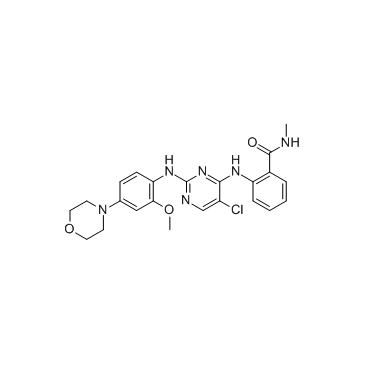TAE226(NVP-TAE226)
Modify Date: 2025-08-22 09:06:55

TAE226(NVP-TAE226) structure
|
Common Name | TAE226(NVP-TAE226) | ||
|---|---|---|---|---|
| CAS Number | 761437-28-9 | Molecular Weight | 468.936 | |
| Density | 1.3±0.1 g/cm3 | Boiling Point | N/A | |
| Molecular Formula | C23H25ClN6O3 | Melting Point | N/A | |
| MSDS | N/A | Flash Point | N/A | |
Use of TAE226(NVP-TAE226)NVP-TAE 226 is a dual tyrosine kinase inhibitor of FAK (IC50=5.5 nM) and IGF-IR (mean IC50=0.14 μM). |
| Name | 2-((5-Chloro-2-((2-methoxy-4-morpholinophenyl)amino)pyrimidin-4-yl)amino)-N-methylbenzamide |
|---|---|
| Synonym | More Synonyms |
| Description | NVP-TAE 226 is a dual tyrosine kinase inhibitor of FAK (IC50=5.5 nM) and IGF-IR (mean IC50=0.14 μM). |
|---|---|
| Related Catalog | |
| Target |
IC50: 5.5 nM (FAK), 3.5 nM (Pyk2), 0.14 μM (IGF-IR), 0.16 μM (c-Met), 0.36 μM (KDR), 0.48 μM (Flt3)[1] |
| In Vitro | NVP-TAE 226 (TAE226), a potent ATP-competitive inhibitor of several tyrosine protein kinases, in particular FAK and IGF-IR kinases. In a cell-based kinase assays, FAK, IGF-IR kinase, and IR kinase are inhibited with an IC50 range of 100 to 300 nM compared with the other kinases tested, which are >10-fold less sensitive. In culture, NVP-TAE 226 inhibits extracellular matrix-induced autophosphorylation of FAK (Tyr395). NVP-TAE 226 also inhibits IGF-I-induced phosphorylation of IGF-IR and activity of its downstream target genes such as MAPK and Akt. NVP-TAE 226 retards tumor cell growth as assessed by a cell viability assay and attenuates G2-M cell cycle progression associated with a decrease in cyclin B1 and phosphorylated cdc2 (Tyr15) protein expression. NVP-TAE 226 treatment inhibits tumor cell invasion by at least 50% compared with the control in an in vitro Matrigel invasion assay. Interestingly, TAE226 treatment of tumor cells containing wild-type p53 mainly exhibits G2-M arrest, whereas tumor cells bearing mutant p53 underwent apoptosis[1]. |
| In Vivo | Treatment with NVP-TAE 226 (TAE226) at 50 or 75 mg/kg extends the median survival of U87 xenograft animals by 6 and 7 days, respectively (P=0.084 and P=0.042, respectively, compared with vehicle-treated animals). However, NVP-TAE 226 treatment of LN229-engrafted animals significantly prolongs their median survival by 19 days (P<0.004 for both dosages, compared with vehicle-treated animals)[1]. |
| Cell Assay | Glioma cell cultures are harvested with 0.05% trypsin and seeded in triplicate at 2×104 in 24-well culture plates for 24 h before drug treatment. Culture medium is used for mock treatment. Cells are harvested at the indicated day after treatment, and viable cells are counted using the Vi-cell viability analyzer. The antiproliferative activity of NVP-TAE 226 (ranging from 0.25 to 1 μM) on cells growing in culture is determined using a tetrazolium-based colorimetric MTT assay[1]. |
| Animal Admin | Mice[1] Male nude mice used for this study are 6 to 8 weeks old. In DMEM/F12 serum-free media (5 μL), 5×105 of U87 cells and 1×106 of LN229 cells per mouse are implanted intracranially through a guide-screw system. Four days after injection of the tumor cells, mice are randomized into three groups for each cell line (n=6). Mice in group 1 are treated with 50 mg/kg NVP-TAE 226 in 200 μL of 0.5% methylcellulose, via an oral gavage. The mice in group 2 receive 75 mg/kg NVP-TAE 226 in 200 μL of 0.5% methylcellulose. The mice in group 3 the same vehicle used for administration of NVP-TAE 226 (control). Treatment frequency is once a day for 5 days and off for 2 days, for a duration of 4 weeks. Mice are monitored daily. Mice are euthanized when they are moribund, and the whole brain is extracted for rapid freezing in liquid nitrogen and storage at -70°C. |
| References |
| Density | 1.3±0.1 g/cm3 |
|---|---|
| Molecular Formula | C23H25ClN6O3 |
| Molecular Weight | 468.936 |
| Exact Mass | 468.167664 |
| PSA | 100.64000 |
| LogP | 2.35 |
| Appearance of Characters | light yellow solid |
| Index of Refraction | 1.659 |
| InChIKey | UYJNQQDJUOUFQJ-UHFFFAOYSA-N |
| SMILES | CNC(=O)c1ccccc1Nc1nc(Nc2ccc(N3CCOCC3)cc2OC)ncc1Cl |
| Storage condition | -20℃ |
| HS Code | 2934999090 |
|---|
| HS Code | 2934999090 |
|---|---|
| Summary | 2934999090. other heterocyclic compounds. VAT:17.0%. Tax rebate rate:13.0%. . MFN tariff:6.5%. General tariff:20.0% |
| 2-[[5-chloro-2-(2-methoxy-4-morpholin-4-ylanilino)pyrimidin-4-yl]amino]-N-methylbenzamide |
| 2-[(5-Chloro-2-{[2-methoxy-4-(4-morpholinyl)phenyl]amino}-4-pyrimidinyl)amino]-N-methylbenzamide |
| Benzamide, 2-[[5-chloro-2-[[2-methoxy-4-(4-morpholinyl)phenyl]amino]-4-pyrimidinyl]amino]-N-methyl- |
| NVP-TAE 226 |
| TAE226 |